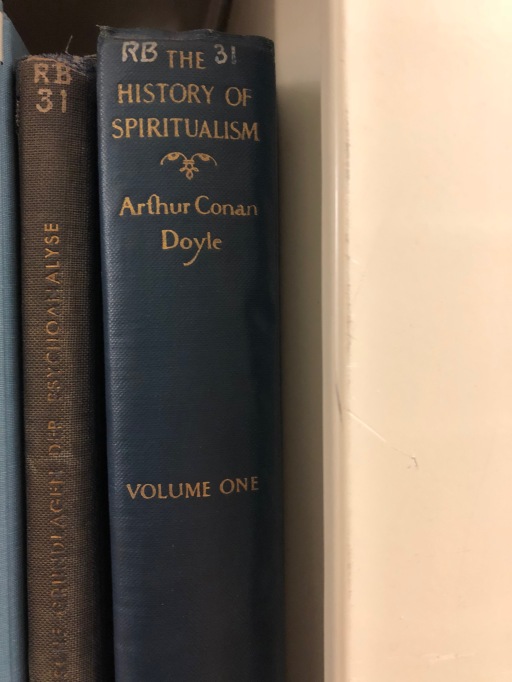By Emily Miranker, Events & Project Manager
Tomorrow is the 159th anniversary of Sir Arthur Conan Doyle’s birth. Best known as the author of the Sherlock Holmes stories, he was a prolific writer beyond his detective fiction writing fantasy-science fiction, humor, plays, poetry, historical novels, and non-fiction. Doyle was trained as a doctor, at the renowned University of Edinburgh Medical School in the late 1870s, so it was not a surprise to me to spot his name on the spine of one of our books here in the library stacks. The title was a bit of a surprise.

A favorite author’s name on a book’s spine catches my eye in the stacks.
Spiritualism was the belief that the spirits of the dead exist and are able to communicate with the living. Spiritualism came to Britain in October 1852 when American Maria Hayden visited London to work as a medium conducting séances and spreading the Spiritualist message.[ii] Along with the technological and scientific innovations of the period, Victorians were also fascinated by the supernatural, paranormal, and occult.
Conan Doyle had a longstanding interest in mystical subjects; he was a Freemason, a founding member of the Hampshire Society for Physical Research in 1889, and he joined the London Society for Psychical Research in 1893.[iii] His Spiritualist beliefs deepened at the height of World War One when war-related deaths abounded, particularly the death of his son Arthur Alleyne “Kingsley” Doyle at the Battle of Somme in 1916. Kingsley was 25.
In The Wanderings of a Spiritualist, Conan Doyle evocatively describes his experiences of a séance held in Merthyr, Wales.
For two hours my wife and I had sat within listening to the whispering voices of the dead, voices which are so full of earnest life, and of desperate endeavours [sic] to pierce the barrier of our dull senses. They had quivered and wavered around us, giving us pet names, sweet sacred things, the intimate talk of the olden time. Graceful lights, signs of spirit power had hovered over us in the darkness. It was a different and a wonderful world. Now with those voices still haunting our memories we had slipped out into the material world—a world of glaring iron works and of twinkling cottage windows. As I looked down on it all I grasped my wife’s hand in the darkness and I cried aloud, “My God, if they only knew—if they could only know!” Perhaps in that cry, wrung from my very soul, lay the inception of my voyage to the other side of the world.[iv]
Many criticized Spiritualist mediums as frauds. Others attributed these other worldly experiences not to chicanery but as hallucinations or the products of mental illness.[v] To 21st century minds it may seem odd that Doyle, a doctor and creator of the supremely logical Sherlock Holmes, was so fervent a believer. Dr. Andrzej Diniejko considers the paradox of Victorian Spiritualism as the “child of rationalism and loss of religious faith; a strange hybrid of science and evolutionary metaphysics which attracted the minds of many people at the turn of the nineteenth century.”[vi] Other notable Victorian Spiritualists included biologist Alfred Russell Wallace, poet Elizabeth Barrett Browning, eventual Prime Minister Arthur Balfour, scientists William Crooks and Oliver Lodge, and novelist Charles Dickens. Even Queen Victoria and Prince Albert attended séances; and in Paris physicists Pierre and Marie Curie did as well (though Marie with far less enthusiasm than her husband).
In an article Doyle wrote for the London spiritualist weekly, Light, in 1917 he stated that “the weight of disproof lies upon those who deny.” He continues, “These phenomena have passed through the stage of being a parlor game; they are now emerging from that of a debatable scientific novelty; and they are, or should be, taking shape as the foundations of a definite system of religious thought, in some ways confirmatory of ancient systems, in some ways entirely new.” Conan Doyle’s belief was such that even risking some tarnish to his reputation he went “on public record as a student of these matters.”[vii]
Conan Doyle died of a heart attack –or passed to the Other Side‑ on July 7, 1930. His son Adrian Doyle informed the New York Times for its obituary that “my father fully believed that when he passed over he would continue to keep in touch with us. All his family believe so, too.”[viii]
That being the case, Happy Birthday Sir Arthur!

